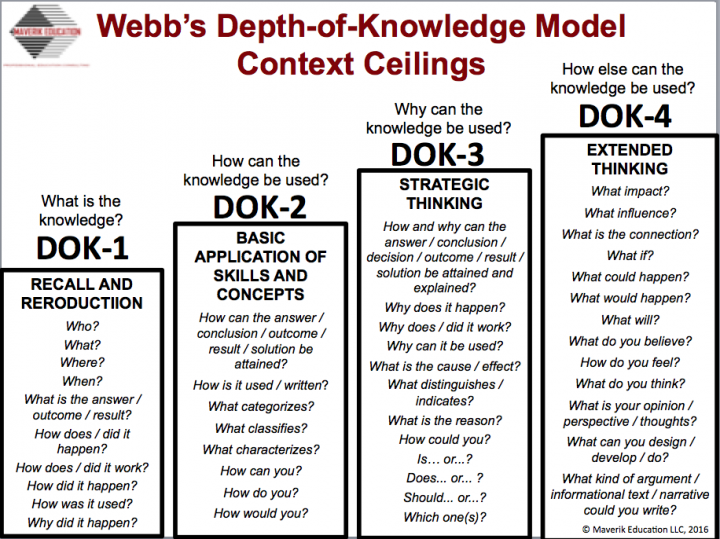DOK Ceilings
Francis, E. "What EXACTLY Is Depth of Knowledge? (Hint: It’s NOT a Wheel!)." ASCD, www.inservice.ascd.org/what-exactly-is-depth-of-knowledge-hint-its-not-a-wheel/. Accessed 23 July 2019.
This visual, designed by Erik Francis of Maverick Education, is intended for teachers to use to plan and provide their instruction and assessment, and also for administrators to use as a guide for observing and evaluating teacher instruction and effectiveness. It is an attempt at a graphic representation that not only embodies Webb’s concept of depth of knowledge but also how Hess, Carlock, Jones, and Walkup explain how the Webb’s DOK model superimposes with Bloom’s Revised Taxonomy in their Cognitive Rigor Matrix.
The visual is called “Webb’s Depth of Model Context Ceilings.” Each block represents how in-depth or extensively students will develop, demonstrate, and discuss their learning. The questions at each level should set the instructional focus and serve as an assessment – formative, summative, or authentic – for student learning. The question stems within the ceilings actually encourage more flexibility in the level of thinking students are expected to demonstrate within these levels.
As Walkup (2014a) says in his blog, “With Depth of Knowledge, context (notably absent in the wheel chart) is everything” – or, as Hess simply puts it, “what comes AFTER the verb” in a performance objective or academic standard establishes the DOK. When planning for teaching and learning for depth of knowledge, consider how deeply or extensively you want your students to go with their learning. Establish the scenario, setting, or situation teaching and learning will be developed, delivered, and demonstrated. That is teaching and learning that promotes depth of knowledge.

